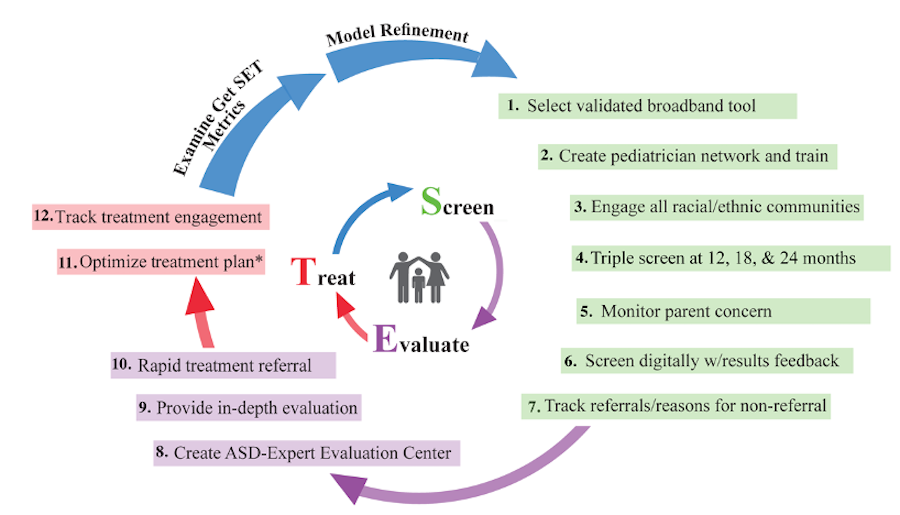Screening & the Get SET Early® Model
What is Screening?
Screening is a way to detect a condition, such as autism, in a population before the onset of full-blown symptoms. There are different types of screening approaches. One approach, universal screening, consists of a whole population receiving screening (e.g., all children that go to their pediatrician for a well-baby check-up) using a validated tool. Sometimes pediatricians engage in universal screening, but sometimes they prefer to screen using their own clinical judgment without the aid of a tool, an approach known as surveillance.
What is the Get SET Early® Model?

The Get SET Early® Model is based on the idea that the goal of medicine is to diagnose and treat serious conditions as quickly as possible. Because autism spectrum disorder (ASD) begins during gestation --likely as early as the first or second trimesters1-3-- it is not only present at birth but it is present at early well-baby visits with pediatricians. Despite the fact that ASD is able to be detected, in many cases, by the first birthday4, and the diagnosis is stable by 14 months5, most toddlers with ASD do not receive a diagnosis and begin treatment until far later at ages 3 to 5 years, a statistic that has remained stable across the past decade6, 7. The considerable time delay between ASD's prenatal onset and eventual detection and treatment could well be a missed opportunity for children and families. Research shows very early treatment (by age ~2 years) increases overall IQ, language abilities, as well as social orienting skills8-10. Some studies go on to suggest that starting treatment at earlier ages results in better overall outcomes than treatment begun later in life11-13.
The Get SET Early® model, developed by Dr. Pierce and colleagues at UC San Diego, is an exciting, collaborative, approach that is designed to facilitate early ASD diagnosis and treatment engagement by having parents and pediatricians work together. Making use of the 12, 18 and 24 month well-baby check-ups, the Get SET Early® model identifies autism through universal screening and immediate referrals for diagnostic evaluations and treatment. The simple 12-steps are illustrated in Figure 1.
This approach expands and improves upon their previous model, the 1-Year Well-Baby Check-Up Approach4. Research on the effectiveness of the new Get SET Early® Model is based on the collaborative effort of 203 pediatricians and 57,603 screens administered at well-baby check-ups in the greater San Diego area. Results of this work are currently Under Review in a scholarly journal.
Figure 1. Schematic illustrating the key components in the Get SET Early® Model

References
1. Courchesne E., Pramparo T., Gazestani V., Lombardo M. V., Pierce K., Lewis N.E. The ASD living biology: From cell proliferation to clinical phenotype. Molecular Psychiatry. 2019;24:88-107.
2. Bonnet-Brilhault F., Rajerison T. A., Paillet C., Guimard-Brunault M., Saby A., Ponson L., et al. Autism is a prenatal disorder: Evidence from late gestation brain overgrowth. Autism Res. 2018;11:1635-1642
3. Courchesne E., Gazestani V. H., Lewis N. E. Prenatal Origins of ASD: The When, What, and How of ASD Development. Trends Neurosci. 2020;43:326-342
4. Pierce K., Carter C., Weinfeld M., Desmond J., Hazin R., Bjork R., et al. Detecting, studying, and treating autism early: the one-year well-baby check-up approach. J Pediatr. 2011;159:458-465 e451-456.
5. Pierce K., Gazestani V. H., Bacon E., Barnes C. C., Cha D., Nalabolu S., et al. Evaluation of the Diagnostic Stability of the Early Autism Spectrum Disorder Phenotype in the General Population Starting at 12 Months. JAMA Pediatr. 2019;173:578-587.
6. Maenner M. J., Shaw K. A., Baio J., EdS, Washington A., Patrick M., et al. Prevalence of Autism Spectrum Disorder Among Children Aged 8 Years - Autism and Developmental Disabilities Monitoring Network, 11 Sites, United States, 2016. MMWR Surveill Summ. 2020;69:1-12 PMC7119644
7. Baio J., Wiggins L., Christensen D. L., Maenner M. J., Daniels J., Warren Z., et al. Prevalence of Autism Spectrum Disorder Among Children Aged 8 Years - Autism and Developmental Disabilities Monitoring Network, 11 Sites, United States, 2014. MMWR Surveill Summ. 2018;67:1-23
8. Wetherby A. M., Guthrie W., Woods J., Schatschneider C., Holland R. D., Morgan L., et al. Parent-implemented social intervention for toddlers with autism: an RCT. Pediatrics. 2014;134:1084-1093 PMC4243066.
9. Dawson G., Rogers S., Munson J., Smith M., Winter J., Greenson J., et al. Randomized, controlled trial of an intervention for toddlers with autism: the Early Start Denver Model. Pediatrics. 2010;125:e17-23 PMC4951085
10. Brian J. A., Smith I. M., Zwaigenbaum L., Roberts W., Bryson S. E. The Social ABCs caregiver-mediated intervention for toddlers with autism spectrum disorder: Feasibility, acceptability, and evidence of promise from a multisite study. Autism Res. 2016;9:899-912 PMC5064621.
11. MacDonald R., Parry-Cruwys D., Dupere S., Ahearn W. Assessing progress and outcome of early intensive behavioral intervention for toddlers with autism. Res Dev Disabil. 2014;35:3632-3644
12. Granpeesheh D., Dixon D.R., Tarbox J., Kaplan A.M., Wilke A.E. The effects of age and treatment intensity on behavioral intervention outcomes for children with autism spectrum disorders. Research in Autism Spectrum Disorders. 2009;3:1014=1022
13. Perry A., Cummings A., Geier J.D., Freeman N.L., Hughes S. , Managhan T. , et al. Predictors of outcome for children receiving intensive behavioral intervention in large, commuinity-based program. Research in Autism Spectrum Disorders. 2011;5
